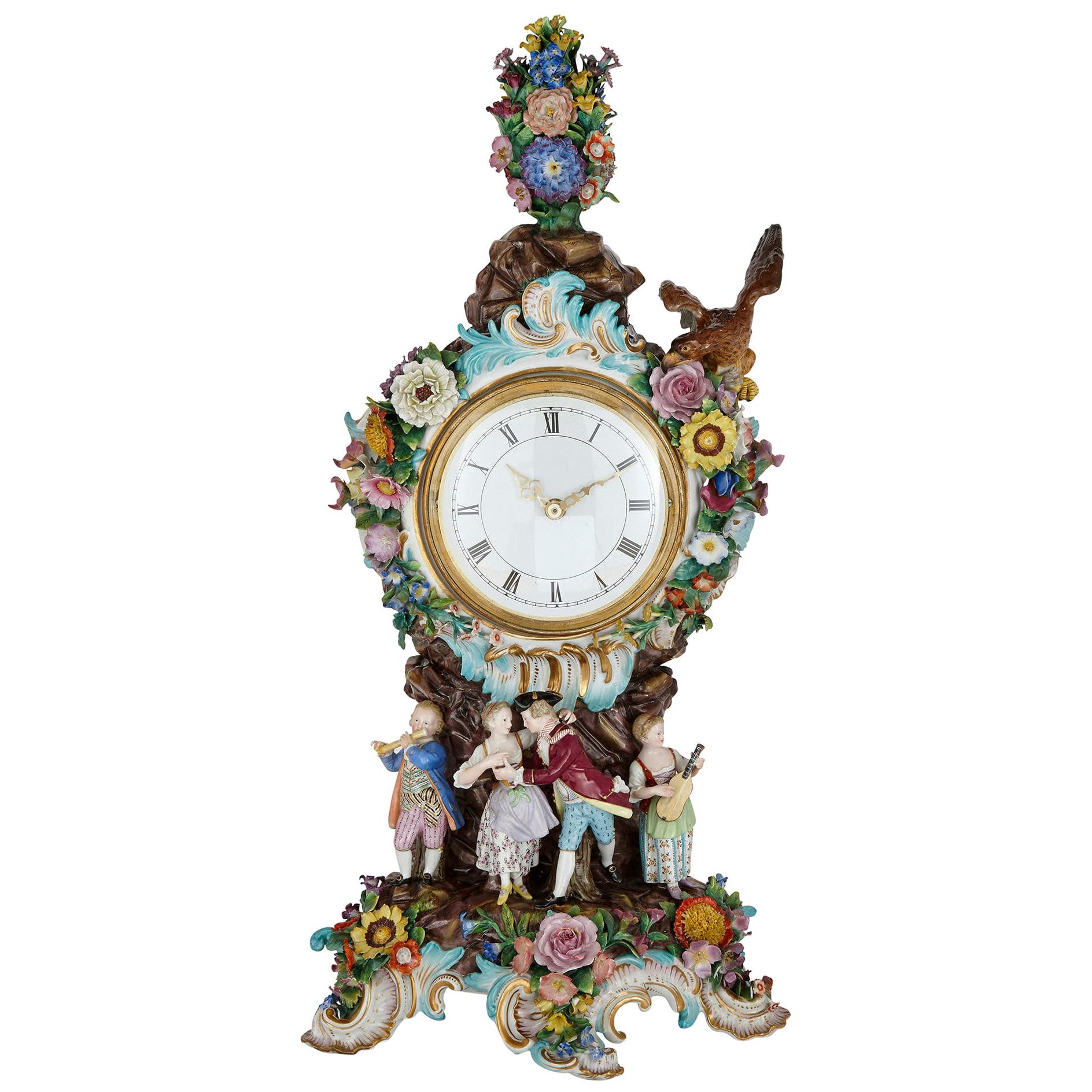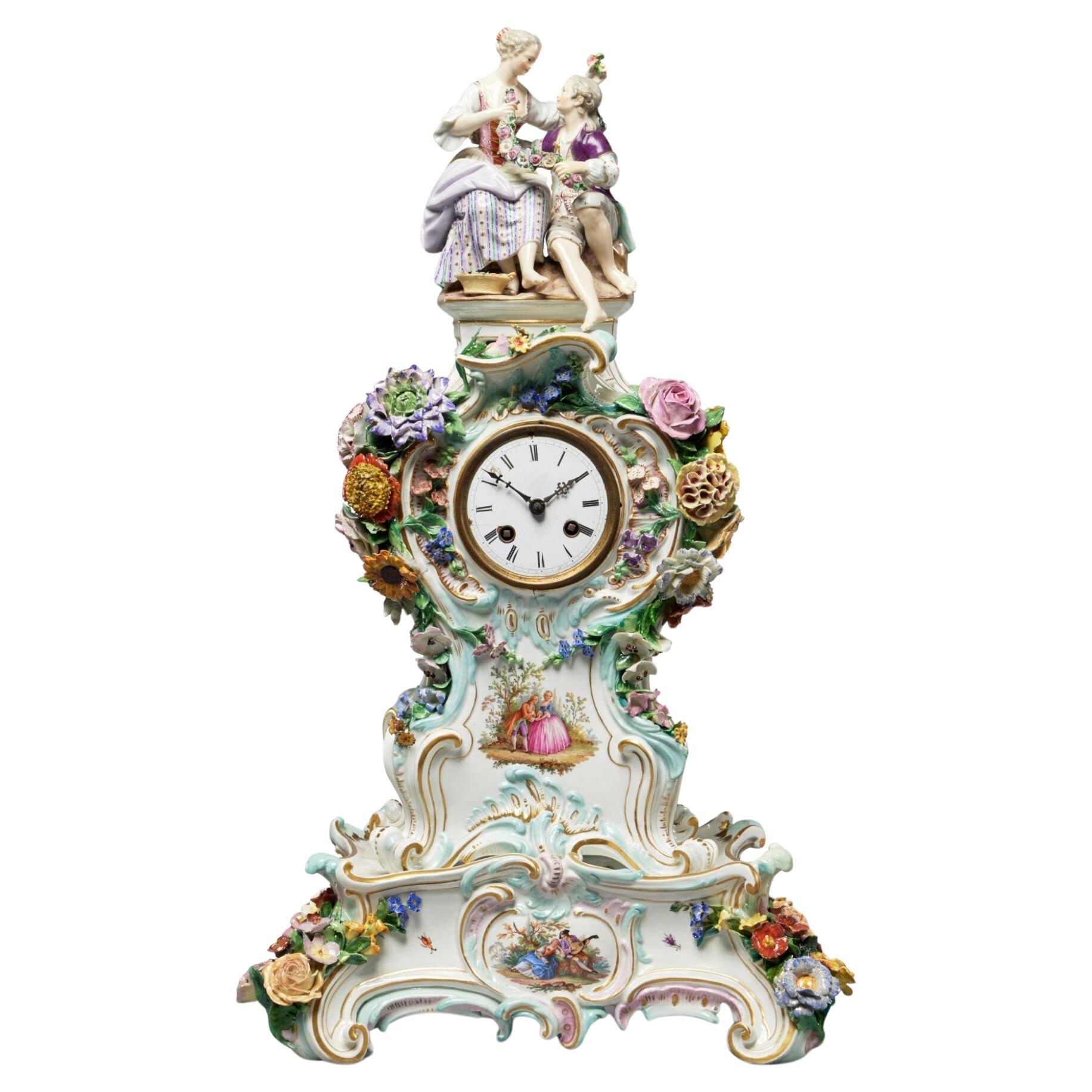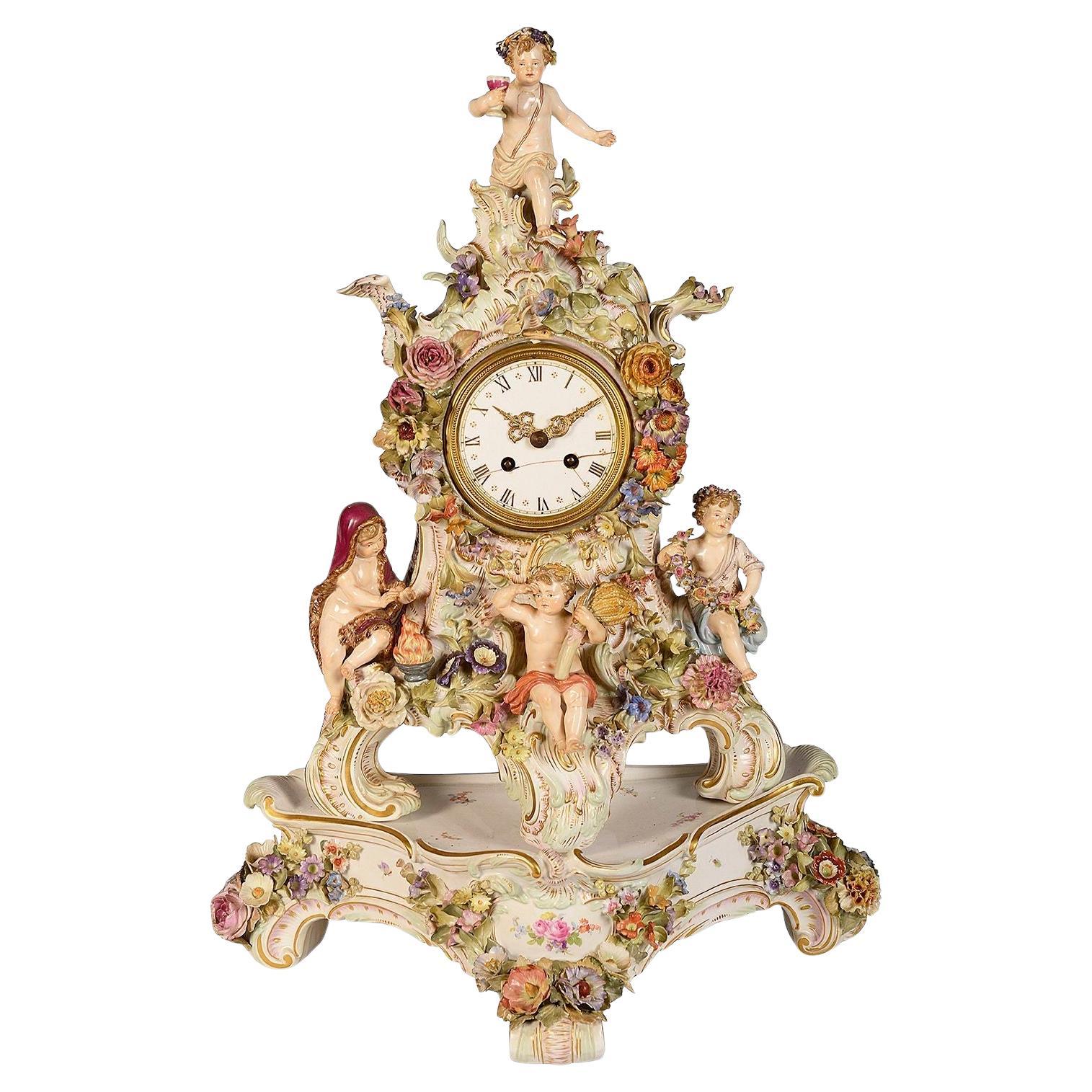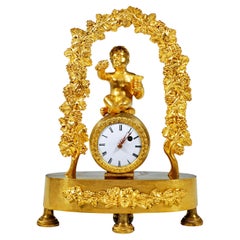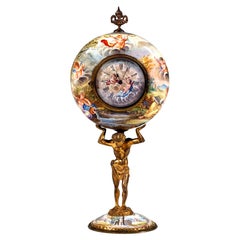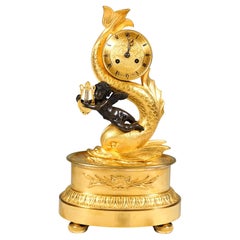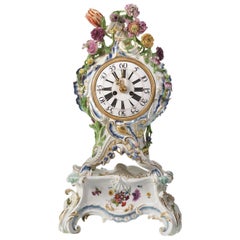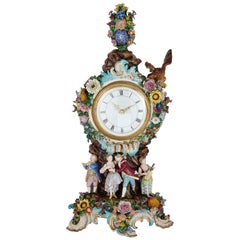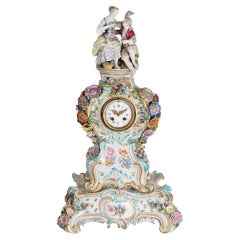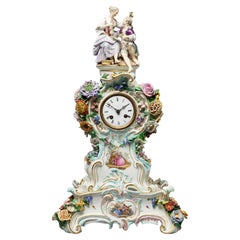Items Similar to Meissen Mantel Table Clock Bronze Porcelain Autumn Fall Kaendler, circa 1745
Want more images or videos?
Request additional images or videos from the seller
1 of 10
Meissen Mantel Table Clock Bronze Porcelain Autumn Fall Kaendler, circa 1745
$5,730.26
$6,80019% Off
£4,223.18
£5,111.8019% Off
€4,800
€5,926.2019% Off
CA$7,843.46
CA$9,493.8619% Off
A$8,785.09
A$10,633.6219% Off
CHF 4,571.17
CHF 5,533.0319% Off
MX$106,694.31
MX$129,144.6119% Off
NOK 57,950.88
NOK 70,144.7319% Off
SEK 54,680.97
SEK 66,186.7819% Off
DKK 36,531.13
DKK 44,217.9019% Off
Shipping
Retrieving quote...The 1stDibs Promise:
Authenticity Guarantee,
Money-Back Guarantee,
24-Hour Cancellation
About the Item
Meissen gorgeous rococo mantel / table clock made of gilded / gilt bronze, excellently decorated with sculptured figurines made of porcelain.
Manufactory: Meissen
Hallmarked: Blue Meissen Sword Mark (bottom of figurines glazed)
First quality
Dating: made circa 1745
impressed number four visible at reverse side
Material:
porcelain, glossy finish (concerning multicolored painted figurines and clockface)
bronze (fire-gilt), concerning various parts of clock (for example base, wine leaves with scrolls and clockcase)
brass (concerning hands)
glass (concerning door of clockface)
Technique: handmade porcelain and fire-gilding (moulded bronze)
Style: Rococo (made second quarter of 18th century)
Table / mantel clock, having clockcase made of fire gilt bronze:
It is surrounded by scrolls of interesting appearance - these ones made of bronze, too -, depicting wine leaves and grapes attached to scrolled stems which seem to spread from trunk growing out from bronze base. There are sculptured figurines attached to base - it is a lovely cherub wearing a wreath of wine grapes on head as well as holding a wooden rod decorated with wine leaves, accompanied by dog which seems to snatch at some wine grapes held in cherub's right hand: It is obvious that we have an ALLEGORY OF FALL / AUTUMN here.
Mentioned figurines probably modelled by circle of
Johann Joachim Kaendler (born in 1706 near Dresden / Germany - died 1775 in Meissen).
Kaendler was chief sculptor at Meissen manufactory as from 1742 until the year 1775.
He is the most famous modeller Meissen manufactory ever had and created well-known series such as Shepherd & Gardener Figurines, Comedian's Children, Gardener Children (with Acier), Paris Town Criers (with Reinicke and Meyer), Gallant figurines, Asian Figurines, Comedians & Harlequins etc.
Porcelain clockface protected by bronze door having slightly domed glass attached to middle area / two hands made of brass (= for hour as well as for minute) existing.
Measures / dimensions:
Table clock:
height 18.0 cm / 7.08 inches
width 15.0 cm / 5.90 inches
depth 9.5 cm / 3.74 inches
Figurines:
height 10.5 cm / 4.13 inches
width 13.0 cm / 5.11 inches
Condition excellent
There aren't any damages existing. - Museum quality (even the wine leaves are in mint condition!). The clock's mechanism is working well (it was checked and cleaned by clockmaker) .
Shipping note:
This Meissen Table Clock will be excellently wrapped and packed in special box.
- Attributed to:Johann Joachim Kaendler (Sculptor)
- Dimensions:Height: 7.08 in (17.99 cm)Width: 5.9 in (14.99 cm)Depth: 3.74 in (9.5 cm)
- Style:Rococo (Of the Period)
- Materials and Techniques:
- Place of Origin:
- Period:1740-1749
- Date of Manufacture:circa 1745
- Condition:There aren't any damages existing. - MUSEUM QUALITY (= even the wine leaves are in MINT CONDITION !). The clock's mechanism is working well (= it was checked and cleaned by clockmaker).
- Seller Location:Vienna, AT
- Reference Number:1stDibs: LU101449468963
About the Seller
5.0
Gold Seller
Premium sellers maintaining a 4.3+ rating and 24-hour response times
Established in 1988
1stDibs seller since 2013
300 sales on 1stDibs
Typical response time: 1 hour
- ShippingRetrieving quote...Shipping from: Vienna, Austria
- Return Policy
Authenticity Guarantee
In the unlikely event there’s an issue with an item’s authenticity, contact us within 1 year for a full refund. DetailsMoney-Back Guarantee
If your item is not as described, is damaged in transit, or does not arrive, contact us within 7 days for a full refund. Details24-Hour Cancellation
You have a 24-hour grace period in which to reconsider your purchase, with no questions asked.Vetted Professional Sellers
Our world-class sellers must adhere to strict standards for service and quality, maintaining the integrity of our listings.Price-Match Guarantee
If you find that a seller listed the same item for a lower price elsewhere, we’ll match it.Trusted Global Delivery
Our best-in-class carrier network provides specialized shipping options worldwide, including custom delivery.More From This Seller
View AllMeissen Splendour Clock With Gardener Figures On Pedestal by Leuteritz, Ca 1880
By Ernst August Leuteritz, Meissen Porcelain
Located in Vienna, AT
The clock and the pedestal were designed by Leuteritz using old forms in the Rococo style:
The clock case rises on a rock base with gold heightened rocailles, richly decorated with d...
Category
Antique 1880s German Rococo Porcelain
Materials
Porcelain
French Ormolu Table Clock, Bacchant Sitting On Wine Barrel, Paris, Around 1840
Located in Vienna, AT
Fire-gilded bronze table clock: a childlike bacchanal seated on a wine barrel under an arched vine arbour, holding grapes and a wine glass in his hands, on an oval base with an appli...
Category
Antique 1840s French Empire Table Clocks and Desk Clocks
Materials
Bronze
Viennese Bronze Enamel Table Clock With Atlas Carrying The Case, Circa 1880
By Viennese Manufactory
Located in Vienna, AT
Artfully decorated fire-gilded and enamelled bronze clock by a Viennese master:
Fully sculpted bronze Atlas on a slightly curved oval base supporting a round clock case, all surfaces...
Category
Antique 1880s Austrian Other Sterling Silver
Materials
Enamel, Bronze
French Ormolu Mantle Clock, Pendule 'Au Dauphin', Paris, Around 1800/1830
Located in Vienna, AT
Exquisite fire-gilded Empire bronze mantel clock: Structure in the form of a tall oval, stepped base with lotus leaf relief, standing on four tubular feet with side engraving, with a...
Category
Antique 1790s French Charles X Table Clocks and Desk Clocks
Materials
Bronze
French Ormolu Mantle Clock, Pendule 'Lit à Baldaquin', Paris, Around 1790
Located in Vienna, AT
Excellent fire-gilded Empire bronze mantel clock: structure in the form of a rectangular, stepped pedestal that tapers at the front corners, on four spindle feet, with relief ornamen...
Category
Antique 1790s French Louis XVI Table Clocks and Desk Clocks
Materials
Bronze
Meissen Potpourri Vase Wine Grapes Monkey Model 1002 by Eberlein Made circa 1860
By Johann Friedrich Eberlein
Located in Vienna, AT
Meissen nice Potpourri vase: Monkey eating wine grapes / lady with boy
The details are stunningly scupltured = finest modelling!
Design:
Johann Friedrich Eberlein (1696-1749) / Model 1002 Created 1748.
Since 1735 second chief modeller of Meissen manufactory, Eberlein was one of the best contributors Johann J. Kaendler had.
Made circa 1860
Hallmarked:
Meissen Blue Sword Mark (glazed bottom)
model number 1002 / painter's number 9 / former's number 70
First quality
Specification:
Excellently modelled bellied vase: The vase's base is of square form type, having four feet shaped as volutes / the vase is painted at front side - it is a picture in Watteau style, depicting a gallant couple situated in garden landscape. Additionally, sculptured decorations are attached to vase's wall - these are vine tendrils with grapes. Very special feature: A sculptured monkey's figurine eating grapes. - Further there is a lady visible - accompanied by little boy with basket...
Category
Antique 1860s German Rococo Porcelain
Materials
Porcelain
You May Also Like
Mantel Clock Meissen Hard, Paste Porcelain, 1745-1755
By Meissen Porcelain
Located in Lantau, HK
The clock was modeled by Johann-Joachim Kaendler, the Meissen Manufacturer’s
most important modeler and designer. Its rocaille style demonstrates the influence of the Rococo trend p...
Category
Antique 18th Century French Rococo Mantel Clocks
Materials
Porcelain
Large Rococo Style Porcelain Mantel Clock by Meissen
By Meissen Porcelain
Located in London, GB
Large Rococo style porcelain mantel clock by Meissen
German, 19th century
Measures: Height 66cm, width 33cm, depth 25cm
This superb mantel clock is a truly wonderful example of ...
Category
Antique 19th Century German Rococo Mantel Clocks
Materials
Porcelain
Meissen porcelain 19th century mantle clock.
By Meissen Porcelain
Located in Brighton, Sussex
An impressive 19th Century Meissen porcelain mantle clock on stand. Depicting seated lovers with a garland of flowers. The white enamel clock face ...
Category
Antique 19th Century German Mantel Clocks
Materials
Porcelain
Exquisite 19th Century Meissen Porcelain Clock Case and Stand
By Meissen Porcelain
Located in Miami, US
This stunning Meissen porcelain clock case and stand exemplifies the luxurious Rococo style of the 19th century, characterized by its elegant shell and foliate scroll silhouette. The...
Category
Antique 19th Century German Rococo Mantel Clocks
Materials
Porcelain
Copy - 19th Century Meissen clock depicting the four seasons.
By Meissen Porcelain
Located in Brighton, Sussex
A fine quality late 19th Century German, Meissen porcelain clock on stand, having wonderful bold traditional colours, the figures representing the four seasons. The clock striking on...
Category
Antique Mid-19th Century German Mantel Clocks
Materials
Porcelain
19th Century Meissen clock depicting the four seasons.
By Meissen Porcelain
Located in Brighton, Sussex
A fine quality late 19th Century German, Meissen porcelain clock on stand, having wonderful bold traditional colours, the figures representing the four seasons. The clock striking on...
Category
Antique 19th Century German Mantel Clocks
Materials
Porcelain
More Ways To Browse
One Year Clock
Blue Porcelain Figurine
Painted Porcelain Dog
Reverse Painted Glass Tables
Blue Porcelain Clocks
Paris Porcelain Clock
Antique Dog Table
Cherub Enamelled Gold
18th Century German Table
Antique Rococo Style Gold Table
Brass Swords
Clock Reverse
Gold Rococo Clock
Antique Wine Box
German Shepherd Antique
Blue Porcelain Mantel Clock
Dog Side Table
Cherub Glass Table

